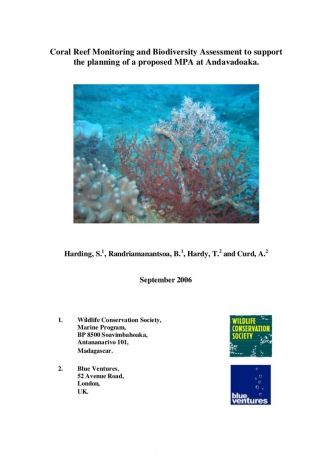Coral reef monitoring was completed for benthic cover, reef fish biomass and macro-invertebrates at nine permanent sites across three main reef types with preliminary information collected at a tenth site (a deep offshore patch reef). Monitoring data provided further detail of coral reef status, complementing and enhancing the existing monitoring completed in the Andavadoaka region.
An assessment of marine biodiversity in the Andavadoaka region was made by international taxonomic experts for hard corals, reef fish and marine molluscs at a range of habitats and reef types.
The condition of coral reefs in the region varied between the main reef types. Nearshore fringing reefs were generally in poor condition with low hard coral cover, high non-calcified algal cover and low reef fish biomass. Seaward facing barrier reefs are in better condition with slightly higher coral cover and reef fish biomass. Patch reefs below 10 metres depth were in the best condition with high coral cover, high structural complexity and greatest reef fish biomass. Extensive coral bleaching events are thought to be responsible for low hard coral cover on shallow reefs (<10 m depth).
Total reef fish biomass (14 main families) was similar to levels found for moderately fished reefs in East Africa and Beheloka, southwest Madagascar. Biomass for some herbivorous fish families was low on fringing reefs (Acanthurids) whilst Scarid biomass was reduced across all sites surveyed.
Macro- invertebrate density varied between the main reef types with higher densities of herbivorous urchins and seastars (Linckia spp.) on fringing reefs and higher densities of giant clams, holothurians and large Cypraeads on offshore reefs.
Biodiversity assessments revealed medium biodiversity levels for hard corals and reef fish and high biodiversity for marine molluscs. Some hard coral genera were recorded less often than expected which is likely to be related to bleaching mortality. Specialist reef fish associated with rich coral areas were also absent.
Biodiversity assessments also showed that in order to adequately conserve the maximum number of species it is necessary to protect the full range of coral reef habitats across the different reef types present in the region. In particular the patch reef complex and the southern end of Nosy Hao reef are recommended for full protection.
A number of recommendations for management are proposed including the use of multiple zones for marine protected and resource-use areas, restrictions on destructive fishing practices, full investigation of a range of alternative livelihoods for fishers and building capacity for community based management within local villages.
It is crucial that management of any designated marine protected areas in the region is made with the full co-operation and continuous support of the local communities.

















